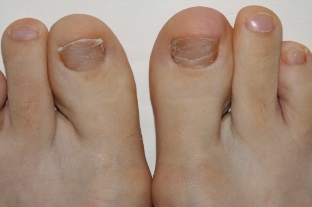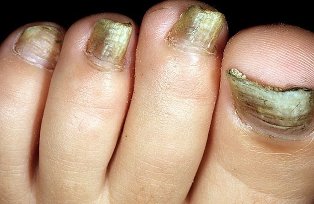Many even unaware that the banal sweating of the feet, accompanied by an unpleasant odor, than suffer from more than half of the population of our planet — one of the main symptoms of nail fungus. This disease the risk of getting sick anyone at least a little bit of neglecting personal hygiene. Nail fungus is lurking everywhere, and especially in the common areas. And the worst part is that the fungus nails — pretty insidious disease: its treatment is long-term and not always successful, because the athlete is prone to relapse. How to timely detect the disease and begin to heal, it is necessary to know all the signs of fungus on the feet.

How disease spreads?
Infection causing parasitic fungi. It is the ideal environment for their reproduction and development — increased moisture combined with a pleasant atmosphere. It is widely known that the main places, where there is a high risk of developing an infection of nail fungus, it is a steam bath, sauna, water parks, swimming pools, manicure salons and so on statistics, However, completely denies this claim: nail fungus, it is possible to pick up the house, through the public affairs (towels, shoes, clothes, carpets, shower or bathtub), if someone from the family members already has this problem, or on the road, e.g. through the shower, kindly proposed by the host (and it may not even have known the presence of the disease).
But what factors have influence on the development of fungal disease? Note of such basic points, which lead to the infection of onychomycosis:
- decrease in immunity;
- injury to the nail plate;
- violation of blood circulation in the lower extremities, which can occur when wearing tight shoes;
- pathology of the feet anatomical character;
- obesity;
- diabetes mellitus;
- excessive sweating.
To at least partially provide for themselves, should only use his things, carefully process the antiseptic bath and shower, use a personal towel, regularly cleaned and washed the carpet, to decontaminate shoes. And be careful, it is favorable for the treatment of mycosis of the moment (I mean, everyone knows that therapy is most effective in the initial stage of development of the disease), it is necessary to know the first signs of nail fungus on your feet.
How to recognize onychomycosis?
The symptoms of nail fungus at different stages may differ from each other, indicating that the progression of infection. For example, on the first (initial) stage, no symptoms virtually absent. On the nail plate can be seen barely visible whitish spots or strips. These symptoms should alert you, because they can talk about the presence of fungal infection. If you ignore the first symptoms of the disease, is the risk to run a sponge that will amaze your healthy nails, and will lead in the future to the formation of pus in the periungual tissues, and it threatens to gangrene and amputation of the lower extremities.
The second stage of a fungal disease of the nails is manifested by the lack of natural shine of the nail plate. Further, the nails change color: pops up the yellowness of white and brown stripes. Can warp in the upper part of the nail and its lateral part. These symptoms are well seen on the photo.
Stty phase onichamykóza characterized by brittleness and a bundle of the nail plate, inflammation of the skin. There is the risk of loss of the nail. But the most annoying is that the disease is further spread to other nails of the lower extremities and to the skin of the feet. The treatment in this case should start immediately, to avoid unpleasant consequences of the disease.

The second and third phase of the onichamykóza sufferer can recognize yourself: your nail acquires a yellow tint or dirty-brown color, it becomes to get soft and dense, lagging behind from the nail bed, becomes very fragile and brittle. Sometimes wearing a closed shoe becomes painful, itchy skin — unbearable (this symptom is especially amplified at elevated sweating). In addition, the cause of suspected onychomycosis can these accompanying symptoms, manifested on the skin, close to located on the nails:
- burning;
- intolerant itching;
- peeling and dryness;
- inflammation;
- crying hotbed;
- thickening and actinic.
Recognizing the first symptoms of nail fungus, it is necessary to immediately turn to a specialist who will prescribe the optimal scheme of treatment.
How do they manifest different types of onichamykóza?
Define the 3 types of onichamykóza, each of which manifests its symptoms.
- Normotroficheskie the fungus is characterized by a change in color of the nail plate: the patient's nails can have shades from white to dark green. In the first stage of the disease on the nail appear white, round or longitudinal spots. With the progression of the disease shade of the nail can vary, and the fungus spreads to the whole area of the nail plate. However, its thickness does not change, yes, and a natural shine remains.
- Hypertrophic nail fungus manifests itself by changing the color of the nail plate, loss of gloss on its surface, the strong thickening and deformation. Toe nails strongly exfoliate, begins their partial destruction.
- Atrophic fungus is characterized by a change in color of the nail with another one of his dilution. The consequence of this fungal lesions is the feeling of rejection sick of the nail or the infected land.
To determine the presence of mold on the fingernails it is possible however to establish the exact diagnosis can only specialist. For this, it is necessary to visit the clinic, to rent on the analysis of the scraping of the sick nail or the skin, located around him. Moreover, the dermatologist will prescribe a microscopic examination.
Signs of fungi on the pathogen of the disease
Success rate treatment of nail fungus depends on how correctly diagnosed the causative agent of the disease. He explains that the illness causes no one type of mold, and several, and each of them is sensitive to certain drugs. This means that if one variety of fungus resistant to one drug, then another originator of this device, is dying.

Most often, nail fungus cause:
- yeast;
- dermatophytes;
- on the mold.
If it is the cause of nail fungus have become the yeast, then expose the disease immediately practically unrealistic. Signs of fungus on the nails on the feet in this case there are the following (take effect after a longer period of time): flaking of the nail plate and light itching of the skin around the nail (the itching may be absent). Injection nails yeast occurs in 4-4,5% of the cases.
Dermatophytes hit the nail makeover far more frequently than the previous originator — this is 94,5% of all cases of infection of nail fungus. Dermatophytes there are three types, injection each of them is manifested in different ways:
- For the first type is characterised by the comprehensive defeat of the feet, legs and nails. The fungus is easily spread on the skin and nails of hands.
- The second type affects only the nail of the little finger or the thumb of the foot. It can spread to the interdigital folds, and how all of the fingers, and some of them.
- The third type is characterized by the defeat of the nails of the thumb and little finger, however, the skin cover the fungus does not affect.
Last view of the fungus — mold. Its pathogen — forms of the fungus. Occurs with this disease only in 1% of cases. Develops a fungus of this kind more often in HIV-infected people.
Other symptoms of fungal nail infection
Often at the beginning of the disease, the telltale signs of fungal lesions of the nail is missing. However, if to be attentive, you may notice some changes in the structure of the nail and its appearance. As has already been mentioned above, the nail plate may occur longitudinal or round whitish spots, the nails can become crooked, while its softness and shine lost. Continues, the disease increasingly destroys the nail plate: first is changing his shade, then the surface of the nail becomes scaly, it thickens, or becomes soft, stratifies, breaks down. The colors on the nails, depends on what kind of mold became the causative agent of the infection.
In addition to the main symptoms of onichamykóza, there are other:

- the fragility of the edge of the nail plate, or all over its surface;
- the distortion of the shapes of the nail, changing its structure;
- the blackening of the nails;
- (plunge) nails under the skin;
- dysbiosis, drowsiness, general weakness;
- the separation of the plate from the nail bed, which leads to the formation of plaque under the nail whitish or yellow in color with an unpleasant odor;
- itching, cracking, burning of the skin in close proximity with was hit by a nail;
- dysbiosis, drowsiness, general weakness.
Any deviations in the appearance of the nails on the foot should alert, because it can talk about the development of nail fungus. The first action in this case — a trip to the dermatologist, who will confirm or refute your fears. If it is not possible to do immediately, the disease will progress. At first glance, there is nothing terrible in this state no. However, in addition to the purely aesthetic problems and discomfort, the fungus may cause serious complications, and up to purulent infection of the affected areas, and even the development of gangrene. So after tightening with treatment, to take measures immediately, as the disease was discovered.





























